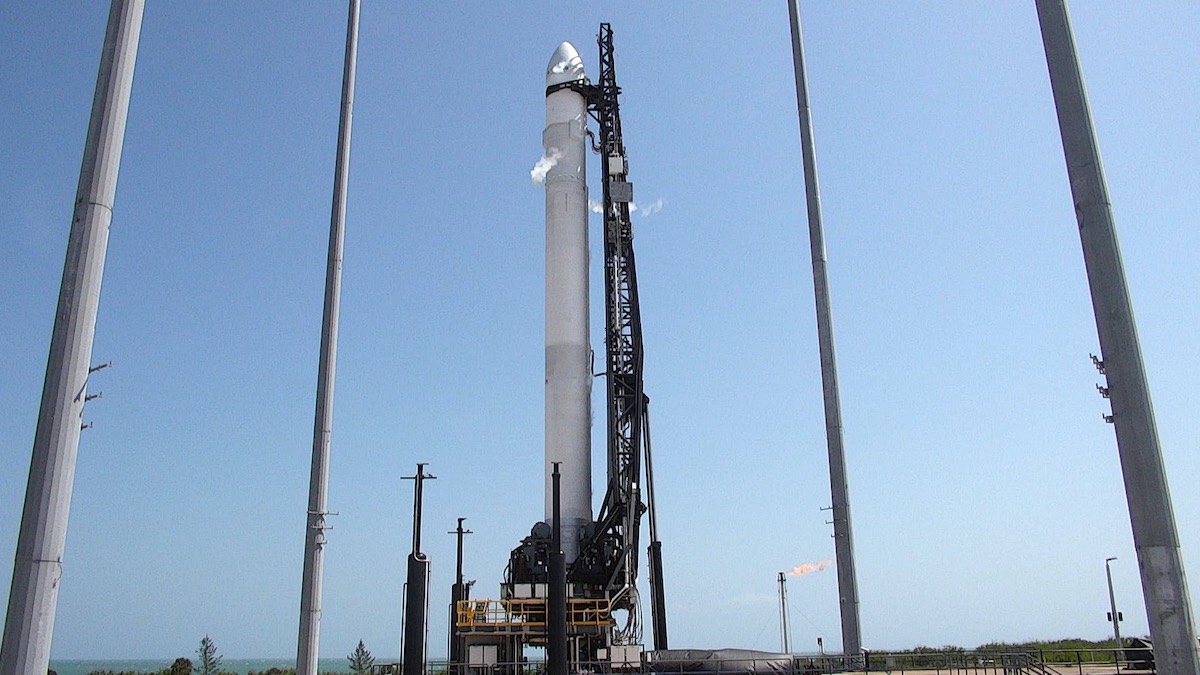
Relativity Space’s first launch countdown aborted about a minute before liftoff Wednesday at Cape Canaveral when sensors detected warmer-than-expected liquid oxygen on the Terran 1 rocket’s second stage, delaying until Saturday the first test flight of the 3D-printed launcher.
The 110-foot-tall (33.5-meter) Terran 1 rocket had a three-hour launch window Wednesday, and Relativity’s launch team counted down to a target liftoff time at 2:40 p.m. EST (1940 GMT). But a computer overseeing final pre-flight checkouts ordered an automatic abort 1 minute and 10 seconds prior to launch.
The countdown stopped to allow time for engineers to evaluate data indicating liquid oxygen on the Terran 1’s upper stage was not at the proper temperature. Relativity’s launch team, working in a control room at Cape Canaveral, initially reset the countdown clock for another run at launch before the end of Wednesday’s window.
But Clay Walker, Relativity’s launch director, called off the countdown: “All parties, we are scrubbing for the day. Thanks for playing.”
The startup aerospace company plans to try again Saturday. The Terran 1 rocket at Launch Complex 16 was drained of methane and liquid oxygen propellants as ground teams set up for another launch attempt during a three-hour window Saturday opening at 1 p.m. EST (1800 GMT).
California-based Relativity Space said the launch team scrubbed the launch attempt Wednesday “due to exceeding launch commit criteria limits for propellant thermal conditions on Stage 2.”
“When using liquid natural gas, the methane needs time to get to the right concentration,” Relativity tweeted. “This is why our next attempt will be a few days from now.”
A SpaceX Falcon 9 rocket is scheduled to take off Thursday afternoon from a launch pad a few miles north of Relativity’s pad with a batch of 40 OneWeb internet satellites. The first stage of the Falcon 9 will return to SpaceX’s landing zone near the Relativity launch site at Cape Canaveral Space Force Station.
There’s a 90% chance of good weather for Relativity’s next launch attempt Saturday.
“A strong cold front is forecast to move across the Florida peninsula Friday night into early Saturday morning,” forecasters from the Space Force’s 45th Weather Squadron wrote in an outlook Wednesday. “Moisture ahead of the front will remain rather limited so we are not expected to see widespread precipitation, although scattered showers and isolated thunderstorms are possible.
“After frontal passage, expect brisk north winds with sustained values of 10-15 mph with gusts to around 20 mph. There could be a few lingering clouds around early in the day (Saturday) but will yield to clear skies through the count. A few cumulus clouds could linger around so the primary concern will be the cumulus cloud rule.”
Relativity Space has nicknamed the Terran 1’s test flight as “Good Luck, Have Fun.” It won’t carry any customer satellites, but will attempt to fly into a 124-mile-high (200-kilometer) orbit about eight minutes after liftoff from Cape Canaveral.
The Terran 1 rocket could become the first methane-fueled launcher to reach orbit if the eight-minute flight goes well Wednesday, beating two much larger rockets — ULA’s Vulcan and SpaceX’s Starship — scheduled to attempt their first full-scale test flights in the coming weeks or months.
Tim Ellis, co-founder and CEO of Relativity Space, said methane is the “propellant choice of the future, especially for reusable rockets.”
Methane is a more efficient fuel than kerosene, which is used on SpaceX’s Falcon 9 rocket, Russia’s Soyuz launcher, and ULA’s Atlas 5. It also burns cleaner and leaves less residue inside an engine than kerosene, easing refurbishment and reuse between missions.
Before the first Terran 1 has even left the launch pad, Relativity started development of a larger fully reusable rocket called the Terran R, a vehicle the company says will become a “point-to-point space freighter capable of missions between the Earth, moon and Mars.”
The Terran 1 is also the first orbital-class rocket to be primarily manufactured with 3D printing.
“Onward, and proud of the team today for a professional and smooth first operation!” Ellis tweeted after Wednesday’s launch delay.
Email the author.
Follow Stephen Clark on Twitter: @StephenClark1.
from Spaceflight Now https://ift.tt/R5CB9DP
via World Space Info







0 comments:
Post a Comment